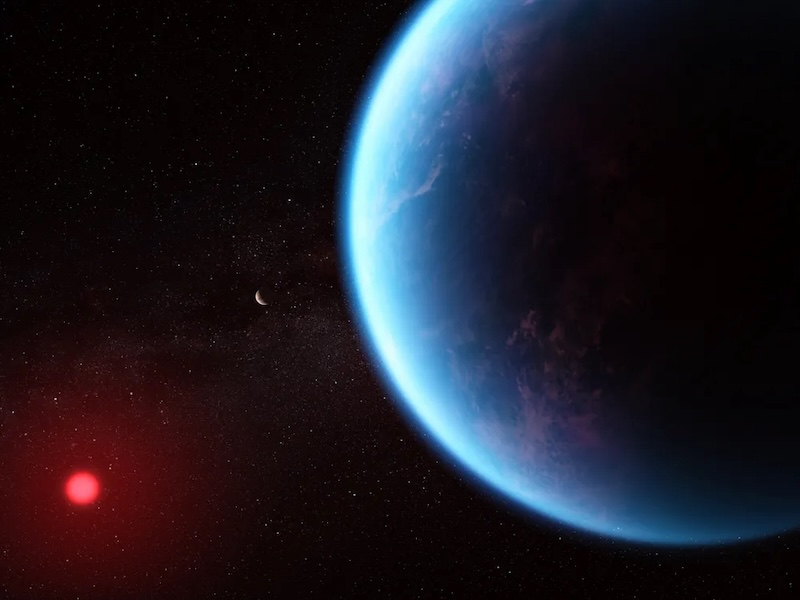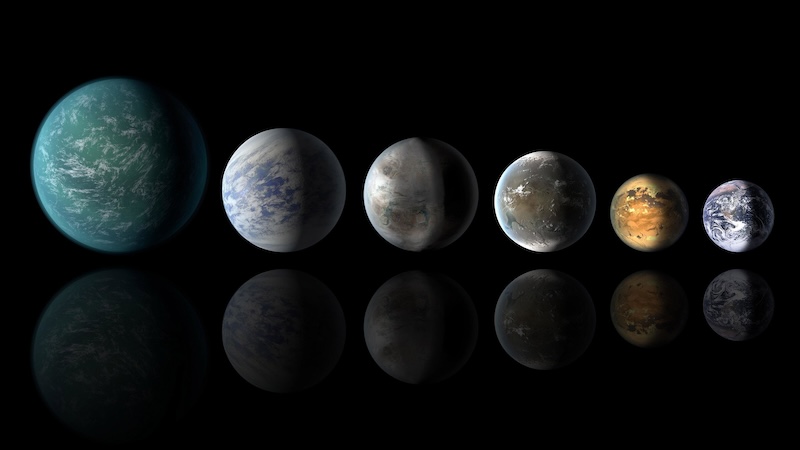
There’s growing evidence for water worlds in our galaxy, worlds even richer in water than Earth. Some distant planets might be true water worlds, completely covered in deep oceans. How can we learn more about them? In late November 2023, scientists at Johns Hopkins University in Baltimore, Maryland, said that haze in the planets’ atmospheres might help. These scientists used a computer model to simulate different kinds of haze on water worlds, with the idea of helping other scientists learn how these worlds form and evolve. They said their study might also provide clues about the habitability – the potential to sustain any form of life, even microbial life – of water worlds.
The researchers published their peer-reviewed paper on November 27 in Nature Astronomy. There is a free preprint of the paper available on arXiv as well.
The 2024 lunar calendars are here! Best Christmas gifts in the universe! Check ’em out here.
Water worlds and the search for life
Water is essential for life, at least life as we know it. So water worlds are an intriguing target for astronomers. Lead author Chao He at Johns Hopkins said:
Water is the first thing we look for when we’re trying to see if a planet is habitable, and there are already exciting observations of water in exoplanet atmospheres.
But haze can be a problem. It can hamper telescopic views of distant worlds in space. That’s true both of telescopes on the ground and in space. Hazes cause opacity – an inability to see clearly – that can mask spectral features from water and other gases in an exoplanet’s atmosphere. Chao He added:
… This haze really complicates our observations, as it clouds our view of an exoplanet’s atmospheric chemistry and molecular features.
How haze on water worlds affects habitability
So haze in exoplanet atmospheres – solid particles suspended in gas – can interfere with astronomers’ observations. But it’s worth noting that haze can have an effect on the habitability of a planet. Haze can influence global temperatures and can affect how much light from the planet’s sun is able to reach its surface. Both of those factors can have an impact on biological activity, either positive or negative.
To try to determine if a water world planet might be habitable, computer modeling is needed. Co-author Sarah Hörst, also at Johns Hopkins, said:
The big picture [of what we’re trying to do] is whether there is life outside the solar system. But trying to answer that kind of question requires really detailed modeling of all different types, specifically in planets with lots of water. This has been a huge challenge. We just don’t have the lab work to do that. So we’re trying to use these new lab techniques to get more out of the data that we’re taking in with all these big, fancy telescopes.
Simulating alien atmospheres
So, how did the researchers simulate the possible atmospheres of water worlds? They used two mixtures of gas containing water vapor and other compounds scientists think are common on exoplanets. Then, the researchers used ultraviolet light to simulate the ultraviolet light coming from the planets’ host stars. It is that light that can react with the a planet’s atmosphere to produce haze. Then, in turn, the researchers wanted to know how the haze particles would react with light in a planet’s atmosphere. To do that, they measured how much light the particles absorbed or reflected.
Further, the research team also compared the data from their simulation to an actual known exoplanet called GJ 1214 b. It was a match! Having the model match a real-world planet gives the scientists confidence they’re on the right track.

Further study of haze on water worlds
Hörst explained:
People will be able to use that data when they model those atmospheres to try to understand things like what the temperature is like in the atmosphere and the surface of that planet, whether there are clouds, how high they are and what they are made of, or how fast the winds go. All those kinds of things can help us really focus our attention on specific planets and make our experiments unique instead of just running generalized tests when trying to understand the big picture.
How many water worlds are there in our galaxy? Could any of them support life? The study of atmospheric hazes on these exotic worlds, and more observations, will help to answer such fascinating questions.
Bottom line: Researchers at Johns Hopkins are simulating haze on water worlds. The haze muddles observations but can also help determine if an exoplanet is habitable.
Read more: Habitable water worlds don’t have to be Earth-like
Read more: Water worlds may be abundant in our galaxy
The post Can haze on water worlds aid in the search for life? first appeared on EarthSky.
from EarthSky https://ift.tt/JjZelpy

There’s growing evidence for water worlds in our galaxy, worlds even richer in water than Earth. Some distant planets might be true water worlds, completely covered in deep oceans. How can we learn more about them? In late November 2023, scientists at Johns Hopkins University in Baltimore, Maryland, said that haze in the planets’ atmospheres might help. These scientists used a computer model to simulate different kinds of haze on water worlds, with the idea of helping other scientists learn how these worlds form and evolve. They said their study might also provide clues about the habitability – the potential to sustain any form of life, even microbial life – of water worlds.
The researchers published their peer-reviewed paper on November 27 in Nature Astronomy. There is a free preprint of the paper available on arXiv as well.
The 2024 lunar calendars are here! Best Christmas gifts in the universe! Check ’em out here.
Water worlds and the search for life
Water is essential for life, at least life as we know it. So water worlds are an intriguing target for astronomers. Lead author Chao He at Johns Hopkins said:
Water is the first thing we look for when we’re trying to see if a planet is habitable, and there are already exciting observations of water in exoplanet atmospheres.
But haze can be a problem. It can hamper telescopic views of distant worlds in space. That’s true both of telescopes on the ground and in space. Hazes cause opacity – an inability to see clearly – that can mask spectral features from water and other gases in an exoplanet’s atmosphere. Chao He added:
… This haze really complicates our observations, as it clouds our view of an exoplanet’s atmospheric chemistry and molecular features.
How haze on water worlds affects habitability
So haze in exoplanet atmospheres – solid particles suspended in gas – can interfere with astronomers’ observations. But it’s worth noting that haze can have an effect on the habitability of a planet. Haze can influence global temperatures and can affect how much light from the planet’s sun is able to reach its surface. Both of those factors can have an impact on biological activity, either positive or negative.
To try to determine if a water world planet might be habitable, computer modeling is needed. Co-author Sarah Hörst, also at Johns Hopkins, said:
The big picture [of what we’re trying to do] is whether there is life outside the solar system. But trying to answer that kind of question requires really detailed modeling of all different types, specifically in planets with lots of water. This has been a huge challenge. We just don’t have the lab work to do that. So we’re trying to use these new lab techniques to get more out of the data that we’re taking in with all these big, fancy telescopes.
Simulating alien atmospheres
So, how did the researchers simulate the possible atmospheres of water worlds? They used two mixtures of gas containing water vapor and other compounds scientists think are common on exoplanets. Then, the researchers used ultraviolet light to simulate the ultraviolet light coming from the planets’ host stars. It is that light that can react with the a planet’s atmosphere to produce haze. Then, in turn, the researchers wanted to know how the haze particles would react with light in a planet’s atmosphere. To do that, they measured how much light the particles absorbed or reflected.
Further, the research team also compared the data from their simulation to an actual known exoplanet called GJ 1214 b. It was a match! Having the model match a real-world planet gives the scientists confidence they’re on the right track.

Further study of haze on water worlds
Hörst explained:
People will be able to use that data when they model those atmospheres to try to understand things like what the temperature is like in the atmosphere and the surface of that planet, whether there are clouds, how high they are and what they are made of, or how fast the winds go. All those kinds of things can help us really focus our attention on specific planets and make our experiments unique instead of just running generalized tests when trying to understand the big picture.
How many water worlds are there in our galaxy? Could any of them support life? The study of atmospheric hazes on these exotic worlds, and more observations, will help to answer such fascinating questions.
Bottom line: Researchers at Johns Hopkins are simulating haze on water worlds. The haze muddles observations but can also help determine if an exoplanet is habitable.
Read more: Habitable water worlds don’t have to be Earth-like
Read more: Water worlds may be abundant in our galaxy
The post Can haze on water worlds aid in the search for life? first appeared on EarthSky.
from EarthSky https://ift.tt/JjZelpy

Aucun commentaire:
Enregistrer un commentaire